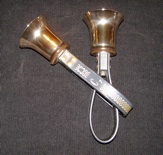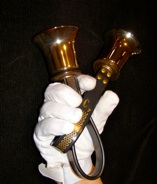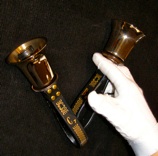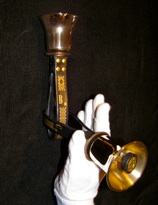There are situations where standard four-in-hand configurations don’t work well. You may have to pick up a preset pair of bells even faster than usual, or at an uncomfortably long reach. Sometimes you have a pair set up for one hand and the next time you pick it up, it’s in the other hand. A bell handle may be too wide to grip between your index and middle finger, especially on Malmark bells or older Schulmerichs. You may find it tiring to hold a pair of bells slightly too large for your hand. In all these examples, interlocked four-in-hand is one possible solution.
Below are different interlocked four-in-hand configurations (all set for the right hand):
Here the bells are set to ring separately, with clappers perpendicular; they can also be rung together in combo ring. Notice that the handle of the interlocked bell is turned sideways. On many bells, this handle thickness is narrower than the handle width, and fits more easily between the index and middle fingers. (You can also use this configuration without locking the bells.) This setup takes less effort to hold, which would be especially useful in a handbell choir or four-in-hand quartet.
Here’s a picture with the bells in hand. The C7 is in the outer (primary) position between the thumb and index finger. The other bell is between the index and middle fingers.
You ring the outer bell toward 10:00, and turn your hand so the thumb is toward you (and pointing across your body) to ring the interlocked bell up and toward 12:00. You can finger damp the outer bell with your thumb or index finger, and the inner bell with your index or middle finger. You can also damp to the shoulder, table, or ribs.
If you set the springs with equal tension on both sides of the clapper, you can ring this configuration with the opposite hand. Simply pass it to your free hand.
You can also rest the back of your hand on the table, release the pair, and pull your hand out from underneath the bells. Then pick up the pair with the other hand, placing your index finger in the space between the castings as usual.
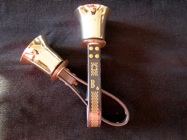 Here’s another possible configuration. Notice that the bell previously outside is now the inner bell. You would hold B6 between your index and middle fingers. I don’t like this as much as the previous setup, but you may find it more intuitive, since you would ring it like “ring and knock.”
Here’s another possible configuration. Notice that the bell previously outside is now the inner bell. You would hold B6 between your index and middle fingers. I don’t like this as much as the previous setup, but you may find it more intuitive, since you would ring it like “ring and knock.”
Here the bells are set for Shelley, and can be rung either together or separately (see Alternate Shelley). This is also a good setup for trilling bells in the same hand. The long fulcrum on the outer bell (here the C7) helps, and the pair is easy to hold. I use this for the trills in Clarke’s Trumpet Voluntary.
The main disadvantage of interlocked four-in-hand is that it makes traveling four-in-hand more difficult. However, it is possible to set this up on the fly. Here I’m inserting the interlocked bell B6 into C7.
To start with the outer bell, hold it vertical and slide it up under the handle of the interlocked bell. Use the same motion, in reverse, to uncouple the bells. (You may find it easier at first to break this apart, rather than set it up.)
Applying interlocked four-in hand: Here’s an example where I found interlocked bells necessary in solo ringing:
In this passage from Meditation from Thais, there isn’t time to walk the length of the table (from D5 to B6) while playing the 16th notes. I had moved D6 and F#6 (sharp is in the key signature, not shown) near the low treble bells, and I preset duplicate interlocked bells A6 and B6 nearby. I used the dotted half note to walk to the other end of the table, carrying F#6 with me. At the far end of the table, I released B6, keeping A6 as a constant. This positioned me for the last measure shown. You may remember this passage from the article on four-in-hand setups, where I talked about pairing sequential bells to buy time to pick up the next pair. When I rework this piece, I plan to pair D6 with F#6 and then carry them together to the other end of the table, which will make this whole passage work more smoothly.
Copyright © 2011 Nancy Kirkner, handbells.com
